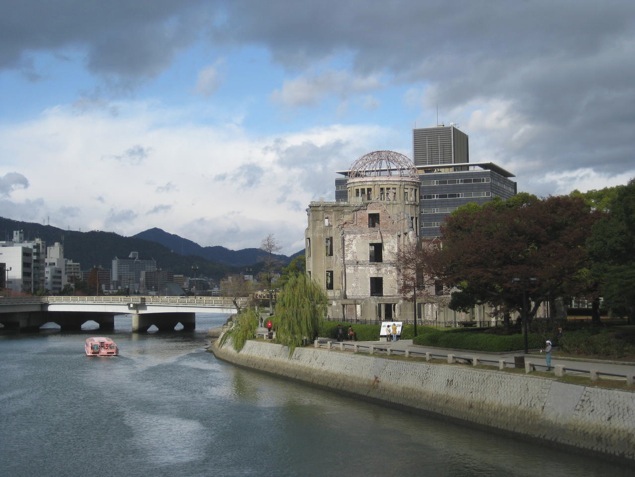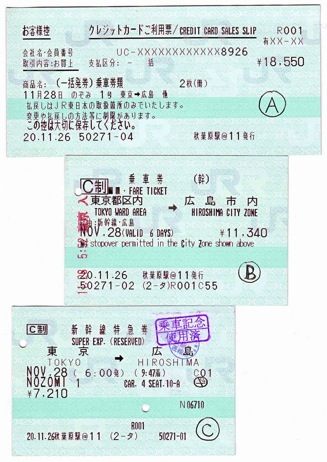


Introduction
This is a personal guide written for anyone planning to attend IETF 76 in Hiroshima. Please visit the official IETF 76 site for registration, accommodation and transportation information provided by the organizers. This guide has 6 sections, click on the 6 headers above the picture to jump directly to the appropriate page, or follow the purple arrow at the bottom to move to the next page. Most of the pictures were taken by myself during various trips to Japan, you can see larger versions by clicking on the images themselves.
A Personal Note
I have only visited Hiroshima twice, once as a 10-year old in 1967, the second in the fall of 2008, when I got to meet the mayor and his entourage. Thus, you shouldn’t use these pages as a detailed guide to the city itself, but rather as general information about Japan, its transportation system, culture and language, and of course: gadgets. What you will NOT find on these pages is information about restaurants since I expect this to be provided by the local host. I’ll just mention that you should try the local speciality: okonomiyaki.
Getting There
1. Airports
The closest international airport to Hiroshima is KANSAI (KIX) built on an artificial island in Osaka bay, main building designed by Renzo Piano. You could also use NAGOYA (NGO) and of course Tokyo’s NARITA (NRT) airport. Given the current economy, some flights to both Kansai and Nagoya are likely going to disappear, but if you have a chance to use Kansai, it’s well worth it — a wonderful airport and about 2 hours closer to Hiroshima by train compared to Tokyo.
2. Stopping in Tokyo at a Hotel
The particular challenge for travelers to and from Hiroshima is that flights from the US to Tokyo may not arrive in time for you to catch the latest train to Hiroshima that same day since all Shinkansen (see #5 below) trains stop running around midnight at the DESTINATION. Travelers from Europe should not face this problem on the way to Hiroshima, but may wish to travel to Tokyo the night before their departure since flights to Europe tend to leave Tokyo in the late morning. For this reason, you may wish to consider a stopover in Tokyo, if only at the airport hotel. The Japan Travel Bureau (JTB) reservation website for IETF 76 will allow you to select a hotel for this purpose (details to follow, check the local host website). The Hilton at Narita airport is both convenient and inexpensive if you’re just looking for a place to sleep before continuing your journey, and central Tokyo offers a wide variety of hotels. Once you’re in Tokyo, there are an estimated 160,000 restaurants to choose from according to the Michelin Guide (which also lists hotels).
3. Bus in to Town
The LAST thing you want to do if you find yourself at Narita airport wanting to go to Tokyo is take a taxi. Taxis are fine for short rides, but Narita is far from the city center and the journey will cost a small fortune and won’t save you any time. If you are going to continue via train to Hiroshima, take the NARITA EXPRESS train to Shinagawa station (it is easier to change to Shinkansen there than at Tokyo station), otherwise, if you need to switch airports in Tokyo (see below) there is a dedicated Airport Limousine Bus that runs between Narita and Haneda airports and that bus company also operates a whole bunch of routes from the airport to various parts of Tokyo, including many door-to-door hotel routes. Tickets from Narita to central Tokyo cost around ¥3,000.
4. Domestic flights to Hiroshima
You can of course also FLY from Tokyo to Hiroshima, but note that the airport for domestic flights is Haneda (near Yokohama) and not Narita, although there appears to be ONE flight per day from Narita to Hiroshima at the time of this writing. From Haneda there are several flights per day, but check the schedules, the last flight doesn’t leave particularly late. If you do end up flying to Hiroshima, you will find easy transportation in to the city provided by Airport Limousine buses.
5. Japan Railways (JR) Shinkansen train to Hiroshima [RECOMMENDED]
Tokyo (main station) is about 4 hours from Hiroshima by Shinkansen and Shin Osaka is about 2 hours away, all times assuming you are using the fastest NOZOMI superexpress train. [Add 1 hour to get to Tokyo from the airport via the Narita Express train or 50 minutes to Shin Osaka by train if you are landing at Kansai.] Travel by train to Hiroshima is the most comfortable and convenient option for most visitors. If you arrive at Narita, there is a JR East Travel Service Center on the B1 (basement level) at both terminals. They can handle both Narita Express and Shinkansen tickets. A similar facility exists at Kansai airport (KIX).
The “bullet train” SHINKANSEN runs all the way from Hakata in the Southern island of Kyushu to the northern part of Honshu (the main island) with plans to eventually extend through the entire chain of islands to Hokkaido by 2020. Service between Tokyo and Hiroshima and beyond is very frequent and you will generally have to wait no more than 20 minutes to board your train if you just show up. Tickets can be purchased from machines, or from JR travel centers at any major station. You can use any major credit card to pay for your journey, but I would recommend carrying more than one card, or enough cash, since (for reasons I do not fully understand) foreign credit cards seem to be frequently rejected by JR. See also information about the JR Rail Pass system if you plan to take more than on long-distance journey. Use the Hyperdia link below to select a train (you want the fast Nozomi service), write down the details and hand your piece of paper to the JR travel agent.
There are three kinds of express trains: Kodama, Hikari and Nozomi, the latter being the fastest. A one-way journey from Tokyo to Hiroshima costs about US $200 for a non-reserved seat and another $80 for the “Green Car” (First Class) supplement. Hyperdia will give you the exact fare in Yen.
When you buy a ticket, you will typically receive up to 3 separate items per journey: A credit card sales slip (A) (use that for your expense report) the base fare ticket (B), and the express portion (C) which contains three crucial pieces of information; train number, car number and seat number. The only other information you’ll need is PLATFORM number, and this is posted on large electronic signs that alter between Japanese and English. Make sure you get the right train, some trains depart very close to each other in time. Sometimes the base fare, express fare and seating info is combined onto ONE ticket. Pass it through the ticket reader on your way to the platform and do the same on the way out at your destination station. If you have two tickets (base and express), pass BOTH tickets (B and C) through the ticket reader AT THE SAME TIME (just put one on top of the other).
Note: If you are paying by cash and wish to retain the ticket(s) as evidence of your purchase then DO NOT pass them through the machine on the way out. Instead go to the far left or far right ticket stall and have a JR employee stamp your ticket. Just say “receipt” and they should know what to do.
Beware: Trains run on time in Japan and spend about 60 seconds in each station. Make sure you are ready to board and standing at the right place on the platform corresponding to your car when the train arrives. Shinkansen trains do not have much space for luggage beyond the overhead shelf, but you can usually store a suitcase behind the last row of seats in any carriage.
Note 2: There is, sadly, no WiFi on the Shinkansen, so relax, enjoy the scenery or bring printed copies of those Internet Drafts that you were supposed to read.
6. Train related Links
See: http://english.jr-central.co.jp/info/timetable/index.html
and: http://en.wikipedia.org/wiki/Shinkansen
and: http://www.hyperdia.com/en/
(That last link lets you plan any journey between any two stations, including subway stations in Tokyo etc).




